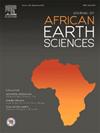布基纳法索Volta盆地:沿前陆Dahomeyide褶皱冲断带前缘的岩性和构造地质约束
IF 2.2
4区 地球科学
Q2 GEOSCIENCES, MULTIDISCIPLINARY
引用次数: 0
摘要
加纳、多哥和贝宁的Volta盆地有一条狭窄的北东向狭长延伸至布基纳法索,泛非Dahomeyide褶皱冲断带靠近古元古代基底岩(约2.25-2.10 Ga)。我们介绍了布基纳法索Volta盆地综合地层学、构造地质学研究的结果,该研究结合了高分辨率遥感图像、辐射测量学和磁学的解释,以评估变质沉积层序和地层环境。我们评估了布基纳法索整个Volta盆地的变形和变质程度,并参考了更广泛的Volta盆地的已发表数据,对构造域进行了背景分析。结果表明,马德约里地块和戈巴南沟地块的长径砂岩和灰岩沉积于托尼期(约1000 ~ 855 Ma),形成于罗迪尼亚大陆被动边缘的浅海环境。在埃迪卡拉纪中期(约635-538 Ma)与后埃迪卡拉纪冰川期(可能是冰川消融期),科加里群的辉长岩、白云岩、硅质岩、磷矿岩(576±13 Ma)和波尔加群的粉砂岩-页岩层序沉积于近海盆地。这些变质沉积岩在D1和D2两次变形事件中发生变形。D1韧性-脆性变形与前陆达荷依德褶皱-冲断带内北西向褶皱-冲断构造相伴随。从Atacora构造单元的等斜褶皱和逆冲构造,到Madjoari地块和Gobnangou地块附近的开敞式低褶皱,整个狭长地带(SE - NW)的变形强度逐渐减弱。变质品位由绿片岩-角闪岩降至极低品位(近变质)。D2脆性变形是渐进式的,在东西向缩短过程中,节理、裂缝走廊、裂缝断裂和开放褶皱形式逐渐发育。本文章由计算机程序翻译,如有差异,请以英文原文为准。

The Volta basin in Burkina Faso: Lithologic and structural geology constraints along the leading edge of the foreland Dahomeyide fold-thrust belt
The Volta basin in Ghana, Togo and Benin has a narrow NE-striking panhandle extension into Burkina Faso where the Pan-African Dahomeyide fold-thrust belt approaches Paleoproterozoic basement rocks (ca. 2.25–2.10 Ga). We present the results of integrated stratigraphic, structural geology studies of the Volta Basin in Burkina Faso that combines interpretations of high-resolution remote sensing imagery, radiometrics and magnetics to appraise the metasedimentary sequences and stratigraphic setting. We evaluate the degree of deformation and metamorphism across the Volta basin in Burkina Faso and contextualize the tectonic domains with reference to published data for the broader Volta Basin.
The results indicate that felspathic sandstones and greywackes of the Madjoari and Gobnangou massifs were deposited in the Tonian Period (ca. 1000-855 Ma) in a shallow marine environment along the Rodinia continental passive margin. Diamictites, dolomite, chert, phosphorite (576 ± 13 Ma) of the Kodjari Group and siltstone-shale sequences of the Porga Group were deposited in an offshore basin in the middle Ediacaran Period (ca. 635-538 Ma) syn-to post Ediacaran glaciation and possibly during a period of deglaciation.
These metasedimentary rocks were deformed during two deformation events, D1 and D2. D1 ductile-brittle deformation was concomitant to NW-directed fold-thrust formation within the foreland Dahomeyide fold-thrust belt. The intensity of deformation decreases across the panhandle (SE to NW) from isoclinal folding and thrust formation in Atacora Structural Unit, to open style low fold forms near the Madjoari and Gobnangou massifs. In concert, metamorphic grade decreases from greenschist-amphibolite to very low grade (anchimetamorphic).
D2 brittle deformation was progressive, with incremental development of joints, fracture-corridors, fracture-faults and open fold forms during east-west directed shortening.
求助全文
通过发布文献求助,成功后即可免费获取论文全文。
去求助
来源期刊

Journal of African Earth Sciences
地学-地球科学综合
CiteScore
4.70
自引率
4.30%
发文量
240
审稿时长
12 months
期刊介绍:
The Journal of African Earth Sciences sees itself as the prime geological journal for all aspects of the Earth Sciences about the African plate. Papers dealing with peripheral areas are welcome if they demonstrate a tight link with Africa.
The Journal publishes high quality, peer-reviewed scientific papers. It is devoted primarily to research papers but short communications relating to new developments of broad interest, reviews and book reviews will also be considered. Papers must have international appeal and should present work of more regional than local significance and dealing with well identified and justified scientific questions. Specialised technical papers, analytical or exploration reports must be avoided. Papers on applied geology should preferably be linked to such core disciplines and must be addressed to a more general geoscientific audience.
 求助内容:
求助内容: 应助结果提醒方式:
应助结果提醒方式:


